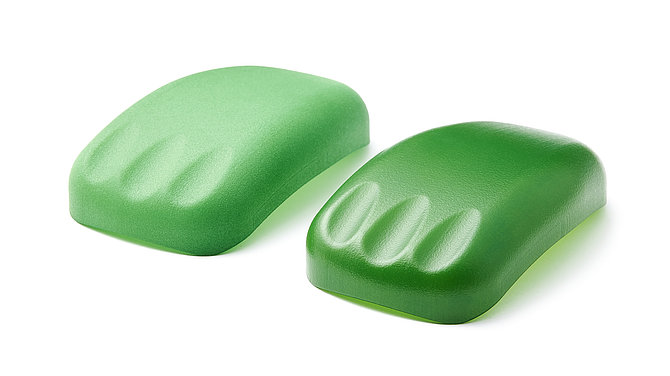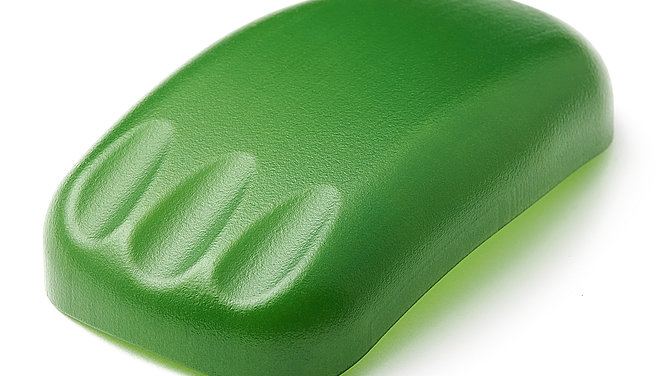It looks simple, performs a simple function, and is simply ingenious – professional trumpeter Jürgen Ellensohn from Vorarlberg had the perfect practice tool for the trumpet, horn, and trombone manufactured by the experts at 1zu1. His invention, the 3D printed, three-centimeter-long TEACH.AIR, makes the flow of air through the mouthpiece both perceptible and audible, helping professional and novice musicians alike to produce cleaner notes right away.
The TEACH.AIR is a plastic tube with a sophisticated internal shape that uses fins, bulges, and notches to achieve the perfect degree of air resistance. When you blow through it, you can hear and feel the resulting air flow – without any pressure or effort. This automatically results in correct breathing and freer playing the next time you pick up the real instrument.
1zu1 was on board as a competent development partner from the initial idea to the first prototypes and all the way to the functional product. We asked inventor Jürgen Ellensohn and 1zu1 project manager Lina Ellensohn, who, as it turned out, is also his distant relative, how this practical tool came into being.
Mr. Ellensohn, how did you come up with the idea for the TEACH.AIR?
Jürgen Ellensohn: I teach at the University of Music in Würzburg. Optimal airflow is a key issue for all brass musicians, both professionals and beginners. Surprisingly, there was no training tool for this on the market, so I’d been wanting to develop one for myself and my students for quite some time. So I tried and tried. To start with, I used various pens and straws as experimental devices.
Even without any prior technical knowledge, I soon realized that I had to design the air resistance inside the tube. So I started drawing – with active support from one of my students, who translated my sketches into a three-dimensional design. That’s how I first came into contact with 3D printing. However, the results were very disappointing; the printed part was inaccurate and unattractive. It didn’t feel right either. I was about to give up.
How did you hear about 1zu1?
Jürgen Ellensohn: That was really just a happy coincidence. Again, it was one of my students who set me on the right track. He told me that he plays music at the Hatler Musig with Hannes Hämmerle, one of the two company founders of 1zu1, and that I should reach out to them. Which I did. Lina approached me and the project finally took off. The first prototype already exceeded all my expectations. After my sobering experience with 3D printing, I couldn’t have imagined this level of precision and quality. But this part looked great, felt perfect, worked almost as intended, and was produced locally to boot.
What was 1zu1’s role in the project?
Lina Ellensohn: Jürgen explained his vision and the object’s intended purpose. We assisted him in an advisory capacity, from the first prototype to the finished product, and contributed our technical knowledge. Our main focus was on finding the best way to implement the part’s complex internal geometry. In terms of the technology and material, we soon decided on selective laser sintering (SLS) and polyamide. We promptly produced the first part and handed it over to Jürgen for him to check and carry out the first practical test.
Several interim versions were needed in order to perfect the air resistance – a total of three prototypes before the production part. The enormous flexibility and production speed with 3D printing helped us a lot during development. After only two days, Jürgen received the revised part. This was then tested and the new findings were fed into the next stage. Agile product development at its best.
What were the main challenges when developing the product?
Lina Ellensohn: The geometry was no problem for us. Instead, the real challenge was to collaboratively produce a functional product without a model. Especially given our respective skill sets – Jürgen is a professional musician and a layman in technical terms; we are professional technicians with a very limited knowledge of music. While most of our projects are technically very demanding, in this case we were dealing with a simple but highly emotional product. And also, from our perspective, a completely new industry.
Jürgen Ellensohn: Ever since my experiments with ballpoint pens, I’ve been aware of one thing: The proof of the pudding is in the eating. Does it feel right? I didn’t stop until I felt sure about that. So intuition and knowledge went hand in hand during the development phase. When the functionality was right, we designed the outer appearance. After all, the TEACH.AIR also needs to look good. That’s how we came up with this miniature trumpet with a length of around three centimeters.
How did your collaboration with 1zu1 develop?
Jürgen Ellensohn: Working with 1zu1 was very pleasant right from the start. Top quality, personalized consultation, and immediate implementation. The speed of our progress always came down to me.
Lina Ellensohn: We like to break new ground with our customers. In this project, we were able to contribute our strengths and quality standards. Thanks to the right production technology, an appropriate material, and some useful tips, we have helped to invent a new product that’s the first of its kind worldwide.
What are the next steps for the TEACH.AIR?
Jürgen Ellensohn: Its success came as a complete surprise. Everyone who tested the TEACH.AIR was thrilled. Initially, we received many orders from professional musicians. First just one unit, then shortly afterwards 20 units – for every brass player in their orchestra or their students. That was a great vote of confidence. To date we’ve produced around 2,000 units. We sell them via our website, through the instrument manufacturer Schagerl and, most recently, the music store Thomann, the largest of its kind in Europe. The orders come in from all over the world, whether from Japan, Korea, Italy, France or Norway. There’s a lot of potential; the music education market is large.
Our interviewees: Professional trumpeter Jürgen Ellensohn is the inventor of the TEACH.AIR. His second cousin, Lina Ellensohn, was responsible for its development as a project manager at 1zu1. The interview was conducted by Joshua Köb, photos by Darko Todorovic.
![[Translate to English:] [Translate to English:]](/fileadmin/_processed_/3/d/csm_20210804_DAT_0106_1200_202513974b.jpg)
![[Translate to English:] Selective Laser Sintering (SLS)](/fileadmin/_processed_/e/c/csm_1zu1-Ameise-Header_b3d4651210.jpg)

![[Translate to English:] Production](/fileadmin/_processed_/2/c/csm_20200910_DAT_1012_v3-1_b0b1c6d9e5.jpg)

![[Translate to English:] [Translate to English:]](/fileadmin/_processed_/c/4/csm_20230315_DAT_0272_1200Px_3e60b5e8c8.jpg)
![[Translate to English:] [Translate to English:]](/fileadmin/_processed_/f/a/csm_O-Ringe_neu_d2d8c537f1.jpg)
![[Translate to English:] [Translate to English:]](/fileadmin/_processed_/3/2/csm_20220310_DAT_0382_1200Px_7f523b73af.jpg)